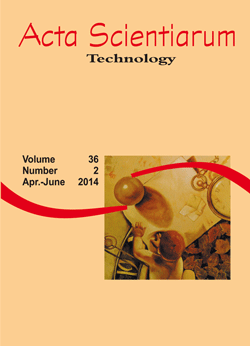<b>Effect of Pr<sub>6</sub>O<sub>11</sub> doping in electrical and microstructural properties of SnO<sub>2</sub>-based varistors<b>
DOI:
https://doi.org/10.4025/actascitechnol.v36i2.17995Keywords:
characterization, tin dioxide, praseodymium oxide, tantalum oxideAbstract
The influence of the dopant Pr6O11 was investigated with regard to the electrical and microstructural properties of the system (98.95-x)%SnO2.1.0%CoO.0.05%Ta2O5.x%Pr6O11, where x = 0.05%, 0.10%, 0.30% and 0.50% in mol. Pr6O11 doping modifies the electrical behavior of the ceramics. The electrical parameters were: α = 8.0, EB = 319 V cm-1 and Vb = 0.66 V barrier-1 for the system without Pr6O11 and α = 17.0, EB = 853 V cm-1 and Vb = 1.15 V barrier-1 with the addition of 0.10% in mol Pr6O11. The system with 0.05% in mol Pr6O11 had the same non-linearity coefficient α as the system with 0.10% in mol. However, breakdown electrical field and voltage per barrier rates were lower (EB = 708 V cm-1 and Vb = 0.98 V barrier-1). The low rates in the breakdown electrical field enabled the varistor systems under study to be used in protection systems for low-voltage energy grids. In the case of Pr6O11 concentrations above 0.10% in mol, the presence of the dopant became deleterious to the varistor´s electrical characteristics. This effect was due to an increase in praseodymium stannate (Pr2Sn2O7) secondary phase. The crystalline phase coupled to the cassiterite (SnO2) phase was found with XRD and SEM/EDS and quantified by Rietveld´s refining method.
Â
Downloads
Downloads
Published
How to Cite
Issue
Section
License
DECLARATION OF ORIGINALITY AND COPYRIGHTS
I Declare that current article is original and has not been submitted for publication, in part or in whole, to any other national or international journal.
The copyrights belong exclusively to the authors. Published content is licensed under Creative Commons Attribution 4.0 (CC BY 4.0) guidelines, which allows sharing (copy and distribution of the material in any medium or format) and adaptation (remix, transform, and build upon the material) for any purpose, even commercially, under the terms of attribution.
Read this link for further information on how to use CC BY 4.0 properly.



















8.png)




